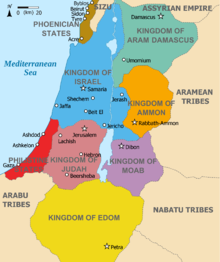Our website is made possible by displaying online advertisements to our visitors.
Please consider supporting us by disabling your ad blocker.
Aram (region)

Aram (Imperial Aramaic: 𐡀𐡓𐡌, romanized: ʾĀrām; Hebrew: אֲרָם, romanized: ʾĂrām; Syriac: ܐܪܡ) was a historical region mentioned in early cuneiforms and in the Bible. The area did not develop into a larger empire but consisted of several small states in present-day Syria. Some of the states are mentioned in the Hebrew Bible, Aram-Damascus being the most outstanding one, which came to encompass most of Syria. In the Bible, Aram-Damascus is simply commonly referred to as Aram.[1][2]
After the final conquest by the rising Neo-Assyrian Empire in the second half of the 8th century and also during the later consecutive rules of the Neo-Babylonian Empire (612–539 BCE) and the Achaemenid Empire (539–332 BCE), the region of Aram lost most of its sovereignty. During the Seleucid period (312-64 BCE), the term Syria was introduced as Hellenistic designation for this region.[3][4] By the beginning of the 5th century, that practice also started to affect terminology of Aramean ecclesiastical and literary elites, and Syrian labels started to gain frequency and acceptance not only in Aramean translations of Greek works, but also in original works of Aramean writers. [5]
Aramaic eventually replaced Akkadian as the lingua franca of the entire region and became the administrative and commercial language of several empires such as the Achaemenid Empire and the Neo-Babylonian Empire.[6][7] Early on, the Christian Bible was translated into Aramaic, and by the 4th century the local Aramaic dialect of Edessa (Urhay) developed into a literary language, known as Edessan Aramaic (Urhaya) or more commonly as Syriac.[8][9]
- ^ "Aram, Aramaeans". Bible Gateway: Encyclopedia of The Bible. Retrieved 22 October 2022.
- ^ BibleGateway.com, ENCYCLOPEDIA OF THE BIBLE, "Aram, Aramaeans", []. Retrieved 28 October 2022.
- ^ Lipiński 2000.
- ^ Younger 2016.
- ^ Minov 2020, p. 255-263.
- ^ "Aramaic language | Description, History, & Facts | Britannica". 10 April 2024.
- ^ Akopian 2017, p. 87.
- ^ Brock 1992a, p. 16.
- ^ Brock 1992b, p. 226.
Previous Page Next Page


